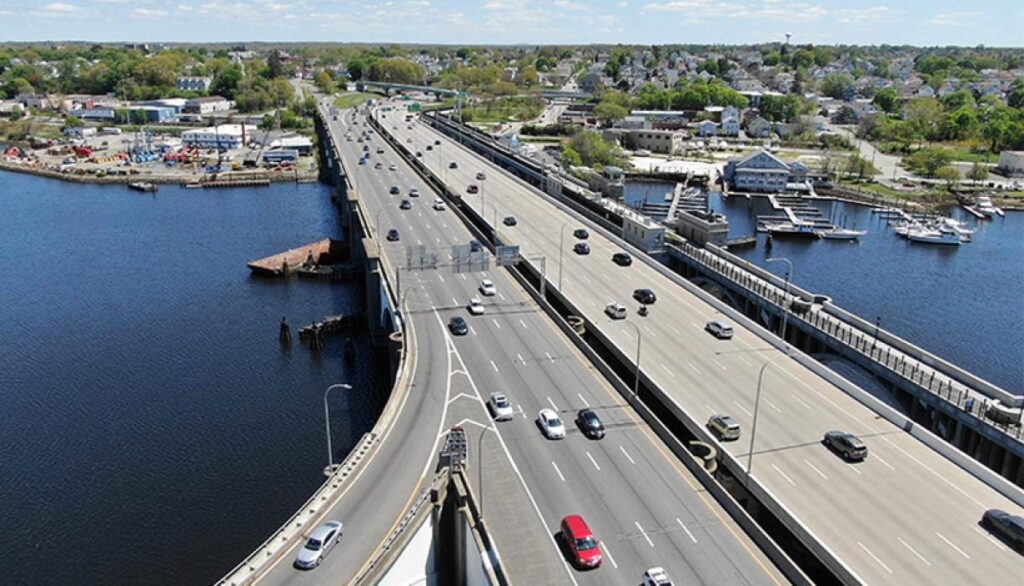Photo courtesy of RIDOT
The Washington Bridge project will address the structural deficiencies of the westbound portion of the Washington Bridge, which carries I-195 over the Seekonk River between East Providence and Providence.
A critical Rhode Island bridge that was partially shut down over safety concerns in December will need to be demolished and replaced, Gov. Dan McKee said March 14.
An independent review of the Washington Bridge — which carries Interstate 195 over the Seekonk River from East Providence to Providence and serves as a key gateway to the capital city — found additional structural deficiencies that require it to be replaced, McKee said at an afternoon press conference.
He added that the state must replace both the bridge’s superstructure and part or all of the substructure.
“We’re going to fix the bridge, we’re going to make it right, and we’re going to make sure we keep people safe,” McKee told reporters.
The Associated Press noted that the governor also vowed that his administration would continue to investigate what led up to the need to shut down and replace the bridge.
“We will hold all responsible parties fully accountable,” McKee explained. “The day of reckoning is coming and coming soon.”
Peter Alviti, director of the Rhode Island Department of Transportation (RIDOT), said the new bridge should be substantially completed with traffic flowing across the structure between March and September of 2026.
The cost to demolish and replace the bridge should be between $250 million and $300 million, he noted, adding that the state is looking at a range of sources for the funding, including federal grants.
Bridge’s Closure Created Traffic Nightmare
The Washington Bridge is made up of a series of three spans carrying I-195, U.S. Highway 6, U.S. 44 and U.S. 1A over the Seekonk River between the Rhode Island capital city and East Providence. Nearly 100,000 vehicles travel over the structure every day.
The sudden westbound closure in mid-December initially wreaked havoc on traffic, turning a 40- to 45-minute drive into several hours, stranding commuters for hours and sending others veering off their normal path. As a result, some schools closed and held classes remotely.
Built in 1969, the westbound portion of the Washington Bridge was rated as “poor,” according to the Federal Highway Administration’s National Bridge Inventory released last June, the AP noted.
The overall rating of a bridge is based on whether the condition of any one of its individual components — the deck, superstructure, substructure, or culvert, if present — is rated poor or below.
Alviti had warned of the Washington Bridge’s poor condition in a 2019 grant application to rehabilitate the bridge and make improvements to traffic flow, writing that it was “nearing a permanent state of disrepair.”
The bridge has an inspection frequency of 24 months, according to federal data. State officials said it was last inspected last July.
During the demolition and construction of the new bridge, the state will reroute six lanes of traffic — three in each direction — onto the separate eastbound bridge structure.
According to Alviti, the state had a structural engineering company determine that it was safe to carry six lanes and followed that up by hiring a second engineering firm to review the first company’s work to confirm the safety of the bridge.
In addition, the U.S. Department of Justice is conducting a separate investigation into the need to suddenly shut down the bridge, he told reporters.
Rhode Island House Speaker Joseph Shekarchi and Senate President Dominick Ruggerio issued a joint statement March 14 acknowledging the disruption facing Rhode Island drivers and pledging to work with the state’s congressional delegation to pursue federal funds.
“We caution that the costs cited today are only estimates,” they said, “and as we have seen in so many projects, construction costs have often exceeded original estimates.”
Read the full article here











